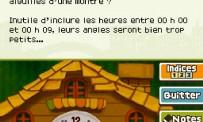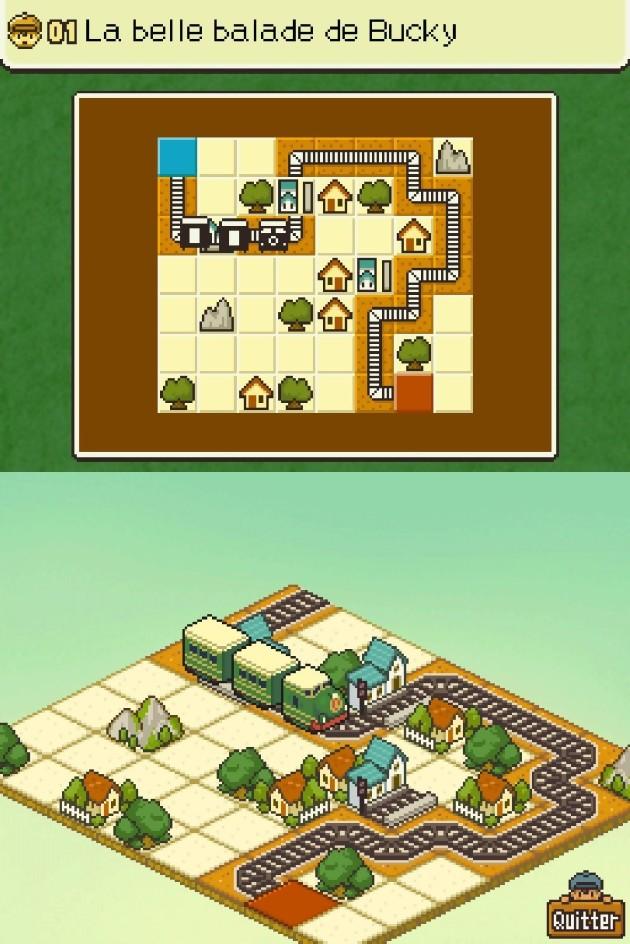 Since the series' inception, Level-5 has been committed to taking a chronological twist in how it approaches each Professor Layton adventure. Wishing to innovate, the Japanese studio offers, not a direct sequel to Professor Layton and the Lost Destiny, but a prologue to the saga. Because, if Lost Destiny led us to visit a "futuristic" London, this new part takes place, meanwhile, three years before the very first episode that led the "so-British" investigator to find the Golden Apple . Professor Layton and the Call of the Specter therefore introduces how our English hero and his young assistant, Luke Triton, came to collaborate and this through their first joint investigation. While yawning at the crows, Layton receives a mysterious letter from Clark Triton, an archaeologist friend, staying in the town of Misthallery. The latter, by means of a coded message, calls on the professor to help him solve an investigation concerning the appearance of a Specter causing trouble in the city. Accompanied by Emmy Altava, then in charge at that time of assisting him, Professor Layton goes there, determined to solve a whole bunch of puzzles. This new adventure thus boycotts the British capital to make us wander in a new city just as vast and very pleasantly modeled. A veritable maze of crossroads and labyrinthine streets, Misthallery is indeed a puzzle fair.
Since the series' inception, Level-5 has been committed to taking a chronological twist in how it approaches each Professor Layton adventure. Wishing to innovate, the Japanese studio offers, not a direct sequel to Professor Layton and the Lost Destiny, but a prologue to the saga. Because, if Lost Destiny led us to visit a "futuristic" London, this new part takes place, meanwhile, three years before the very first episode that led the "so-British" investigator to find the Golden Apple . Professor Layton and the Call of the Specter therefore introduces how our English hero and his young assistant, Luke Triton, came to collaborate and this through their first joint investigation. While yawning at the crows, Layton receives a mysterious letter from Clark Triton, an archaeologist friend, staying in the town of Misthallery. The latter, by means of a coded message, calls on the professor to help him solve an investigation concerning the appearance of a Specter causing trouble in the city. Accompanied by Emmy Altava, then in charge at that time of assisting him, Professor Layton goes there, determined to solve a whole bunch of puzzles. This new adventure thus boycotts the British capital to make us wander in a new city just as vast and very pleasantly modeled. A veritable maze of crossroads and labyrinthine streets, Misthallery is indeed a puzzle fair.
Ghostbusters
 Returning to the origins of the series, Professor Layton and the Call of the Specter shows a bit of freshness by offering us to rediscover the main characters with a new eye. A good opportunity for players insensitive to the series, to throw themselves body and soul without feeling aggrieved by any references to previous iterations. The appreciable staging, in particular punctuated by short but numerous cutscenes and served by an intrigue gaining in intensity as the progression progresses, is also a lot to do with it. The revelations are not lacking and the interest of the player is constantly revived when the various stages of the investigation are resolved. So to speak, the players will have the impression of solving not one and the same investigation but several, as the branches during the adventure are varied. The scenario is therefore very well illustrated and it is therefore very easy to take yourself for a budding detective and to go on various assumptions by keeping abreast of the latest revelations via the "Journal" and the "Mysteries" menu. To improve understanding of the events and provide some clarification on certain protagonists, short textual phases are also to be unlocked and accentuate the immersion. A few words finally for the dubbing, always so nice, even if in general, the text dialogues abound and are still lacking. A slight problem present in the previous episodes which unfortunately did not pay a little more attention. However, if the realization certainly shows slightly more ambition, the game mechanics proves, for the license, quite classic.
Returning to the origins of the series, Professor Layton and the Call of the Specter shows a bit of freshness by offering us to rediscover the main characters with a new eye. A good opportunity for players insensitive to the series, to throw themselves body and soul without feeling aggrieved by any references to previous iterations. The appreciable staging, in particular punctuated by short but numerous cutscenes and served by an intrigue gaining in intensity as the progression progresses, is also a lot to do with it. The revelations are not lacking and the interest of the player is constantly revived when the various stages of the investigation are resolved. So to speak, the players will have the impression of solving not one and the same investigation but several, as the branches during the adventure are varied. The scenario is therefore very well illustrated and it is therefore very easy to take yourself for a budding detective and to go on various assumptions by keeping abreast of the latest revelations via the "Journal" and the "Mysteries" menu. To improve understanding of the events and provide some clarification on certain protagonists, short textual phases are also to be unlocked and accentuate the immersion. A few words finally for the dubbing, always so nice, even if in general, the text dialogues abound and are still lacking. A slight problem present in the previous episodes which unfortunately did not pay a little more attention. However, if the realization certainly shows slightly more ambition, the game mechanics proves, for the license, quite classic.
Elementary, my dear Layton!
 Let's get down to the basics: the puzzles. If the regulars of the series will be far from being surprised in their construction, the newcomers will have the pleasure of benefiting from the most exhaustive list of puzzles of the saga. Whether logical, mathematical, or comical, none are truly alike. The title is therefore built, above all, around the presence of many NPCs – the inhabitants of Misthallery – in charge of providing some of the puzzles present. It is without counting on those hidden here and there and to reveal by tapping, using the stylus, the suspicious elements of the decorations. In addition, a reserve of additional puzzles, taking the form of a purple cat named Keats (don't look for logic there, there is none) will occupy certain streets of the city. But the real plus of the title, a shy facet of the previous part, is the ability of the developers to have energized the scenario by inserting several mandatory puzzles. Indeed, more action phases in the story will require you to solve certain puzzles to progress in the adventure or simply to have access to new areas. We regret that this type of puzzle is for the most part not very complicated to solve, a facet that is probably voluntary so as not to block the average player for too long. And as if help were not enough, Professor Layton and the Call of the Specter reintegrates the system of clues and the famous SOS coins, the latter to be unearthed in the environments. In the event that certain puzzles prove to be too complicated, the players can therefore, in exchange for these coins, reveal clues, including the "clue +" which, so to speak, is responsible for revealing the ultimate answer. Avoid if you want to put your brains to work, the game still offering good headaches. Like these predecessors, players will therefore have enough to exercise their brains with the 170 puzzles on offer. Without forgetting the few mini-games that include the image of the "mini-express" or the "Puppet" mode in which it is a question of recovering throughout the adventure expressions to carry out a show of dolls . As the youngest of the family, Professor Layton and the Call of the Specter is therefore doing rather badly.
Let's get down to the basics: the puzzles. If the regulars of the series will be far from being surprised in their construction, the newcomers will have the pleasure of benefiting from the most exhaustive list of puzzles of the saga. Whether logical, mathematical, or comical, none are truly alike. The title is therefore built, above all, around the presence of many NPCs – the inhabitants of Misthallery – in charge of providing some of the puzzles present. It is without counting on those hidden here and there and to reveal by tapping, using the stylus, the suspicious elements of the decorations. In addition, a reserve of additional puzzles, taking the form of a purple cat named Keats (don't look for logic there, there is none) will occupy certain streets of the city. But the real plus of the title, a shy facet of the previous part, is the ability of the developers to have energized the scenario by inserting several mandatory puzzles. Indeed, more action phases in the story will require you to solve certain puzzles to progress in the adventure or simply to have access to new areas. We regret that this type of puzzle is for the most part not very complicated to solve, a facet that is probably voluntary so as not to block the average player for too long. And as if help were not enough, Professor Layton and the Call of the Specter reintegrates the system of clues and the famous SOS coins, the latter to be unearthed in the environments. In the event that certain puzzles prove to be too complicated, the players can therefore, in exchange for these coins, reveal clues, including the "clue +" which, so to speak, is responsible for revealing the ultimate answer. Avoid if you want to put your brains to work, the game still offering good headaches. Like these predecessors, players will therefore have enough to exercise their brains with the 170 puzzles on offer. Without forgetting the few mini-games that include the image of the "mini-express" or the "Puppet" mode in which it is a question of recovering throughout the adventure expressions to carry out a show of dolls . As the youngest of the family, Professor Layton and the Call of the Specter is therefore doing rather badly.
PROFESSOR LAYTON AND THE CALL OF THE SPECTRUM VIDEO TEST































